Gekesai Di Ichi / Ni
Gekisai (kanji: 撃砕; katakana: ゲキサイ) means "attack and destroy". These kata were created around 1940 by Chojun Miyagi and Nagamine Shoshin as beginners' kata, to introduce the basic forms of karate (kihon) to middle school students in Okinawa, to help bring about the standardization of karate, and to teach a basic set of techniques for self-defense Gekisai kata were strongly influenced by the Shuri-te techniques that Master Miyagi learned from Master Anko Itosu
Students first learn gekisai dai ichi and then gekisai dai ni. The main difference between dai ichi and dai ni is that dai ni introduces open handed techniques and new stances It is in gekesai dai nithat students are introduced to the neko ashi dachi stance, and to the wheel block(Tomai Uke).
Gekesai Di Ichi
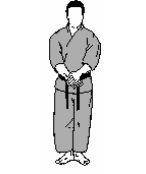
Gekesai Di Ni
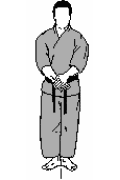
Saifa
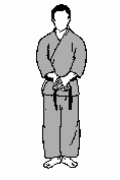 Saifa (Kanji: 砕破; Katakana: サイハ) means "smash and tear". Saifa has its origins in China, and was brought to Okinawa by Higashionna. It contains quick whipping motions, hammerfists, and back fist strikes; it particularly emphasizes moving off-line from an opponent's main force, while simultaneously closing distance and exploding through them. This is usually the first advanced Gōjū-ryū kata the students learn in most goju kaiha, after gekisai dai ichi and gekisai dai ni.
Saifa (Kanji: 砕破; Katakana: サイハ) means "smash and tear". Saifa has its origins in China, and was brought to Okinawa by Higashionna. It contains quick whipping motions, hammerfists, and back fist strikes; it particularly emphasizes moving off-line from an opponent's main force, while simultaneously closing distance and exploding through them. This is usually the first advanced Gōjū-ryū kata the students learn in most goju kaiha, after gekisai dai ichi and gekisai dai ni.
Seinchin
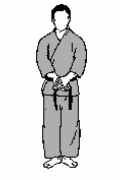 Seinchin (kanji: 制引戦; katakana: セイユンチン (attack, conquer, suppress; also referred to as "to control and pull into battle") is a Kaishu Kata of the Goju-ryu style of karate-do. It was taught by Goju-ryu's founder, Master Chojun Miyagi. Seinchin is thought to mean "Marching Far Quietly.""Seinchin's origin lies in the internal system of Wu-shu, Hsing-I. Seiunchin's direct translation through time has been lost, but many Goju-ryu Karateka refer to it as Marching far Quietly. Seinchin is a unique kata because only hand techniques are used. An advanced kata, Seiunchin works a lot on the shiko dachi and incorporates strike such as the back fist and elbow. Along with Sesan, Seinchin is the other training Kaishu of Meibukan Goju-ryu, which is best suited for a smaller man with less physical power. Many times in the kata techniques are performed with the other hand used as re-enforcement!" - From 'Origin and Characteristics of Goju-ryu Kaishu Kata'.
Seinchin (kanji: 制引戦; katakana: セイユンチン (attack, conquer, suppress; also referred to as "to control and pull into battle") is a Kaishu Kata of the Goju-ryu style of karate-do. It was taught by Goju-ryu's founder, Master Chojun Miyagi. Seinchin is thought to mean "Marching Far Quietly.""Seinchin's origin lies in the internal system of Wu-shu, Hsing-I. Seiunchin's direct translation through time has been lost, but many Goju-ryu Karateka refer to it as Marching far Quietly. Seinchin is a unique kata because only hand techniques are used. An advanced kata, Seiunchin works a lot on the shiko dachi and incorporates strike such as the back fist and elbow. Along with Sesan, Seinchin is the other training Kaishu of Meibukan Goju-ryu, which is best suited for a smaller man with less physical power. Many times in the kata techniques are performed with the other hand used as re-enforcement!" - From 'Origin and Characteristics of Goju-ryu Kaishu Kata'.
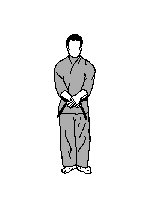 Sanseru
Sanseru
Sanseru is a karate kata of Southern Chinese (Fujianese) origin. The name literally means thirty-six (steps, or positions of attack and defense) Versions of it are found in several karate styles, including Goju-ryu, but it is most strongly associated with Uechi-ryu and the related system Shohei-ryu.
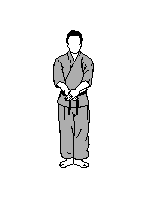 Sepai
Sepai
Sepai - Kanji: 十八手 - Katakana: セイパイ (18 Hands): Seipai incorporates both the four directional movements and 45° angular attacks and implements techniques for both long distance and close quarter combat. This was a Seikichi Toguchi's specialty kata.
Sisochin
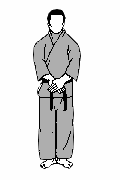 Sisochin (四向鎮?) is a kata of naha-te karate style, whose authorship has been mentioned as a Kanryo HigaonnaThere are two theories that explain the origins of kata Sisochin: the first suggests that the shape or style comes from white heron or the Tiger, Shaolin kung fu, the other it is from mantis style.It is said that the kata was introduced in Okinawa through the Master Higaonna, when he returned from his trip he made to Fuchi, in Fujian province, where he learned the exercise from the master Ryu Ryu Ko, although some of circumstances did not corroborate the version, it seems that there was already a version of the kata, taught by master Seisho AragakSisochin begins at the stance Sanchin dashi in three kyodo when applying three successive nukite zuki. De facto, there is a predominance of kaisho waza techniques - open hands -. The posture is eclectic, with high and low stances, highlighting the feature of adaptability. Besides Sanchin dashi, are well marked and ayumi dashi and zenkutsu dashi.
Sisochin (四向鎮?) is a kata of naha-te karate style, whose authorship has been mentioned as a Kanryo HigaonnaThere are two theories that explain the origins of kata Sisochin: the first suggests that the shape or style comes from white heron or the Tiger, Shaolin kung fu, the other it is from mantis style.It is said that the kata was introduced in Okinawa through the Master Higaonna, when he returned from his trip he made to Fuchi, in Fujian province, where he learned the exercise from the master Ryu Ryu Ko, although some of circumstances did not corroborate the version, it seems that there was already a version of the kata, taught by master Seisho AragakSisochin begins at the stance Sanchin dashi in three kyodo when applying three successive nukite zuki. De facto, there is a predominance of kaisho waza techniques - open hands -. The posture is eclectic, with high and low stances, highlighting the feature of adaptability. Besides Sanchin dashi, are well marked and ayumi dashi and zenkutsu dashi.
The kata is symmetrical. And, alternating atemi waza, there are also projection techniques - nage waza - and grasping.
Seisan
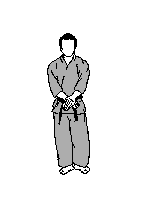 Seisan (alternate names: Sesan, Seishan, Jusan, Hangetsu) literally means '13', however some people refer to the kata as '13 Hands', '13 Fists', '13 Techniques', '13 Steps' or even '13 killing positions'. However, all these names are made up and have no historical basis.Seisan is thought to be one of the oldest kata quite spread among other Nahate schools. Shito-ryu has its own version and different versions are now practised even in Shurite derivatives like Shotokan (called Hangetsu) and in Wado-ryu (called Seishan). Isshin-ryū also adopted this kata. This kata is also practiced in Korean styles such as Tang Soo Do and Soo Bahk Do and is called Sei-Shan or Seishan in Korean. Due to its difficulty, this kata is often reserved for advanced students.
Seisan (alternate names: Sesan, Seishan, Jusan, Hangetsu) literally means '13', however some people refer to the kata as '13 Hands', '13 Fists', '13 Techniques', '13 Steps' or even '13 killing positions'. However, all these names are made up and have no historical basis.Seisan is thought to be one of the oldest kata quite spread among other Nahate schools. Shito-ryu has its own version and different versions are now practised even in Shurite derivatives like Shotokan (called Hangetsu) and in Wado-ryu (called Seishan). Isshin-ryū also adopted this kata. This kata is also practiced in Korean styles such as Tang Soo Do and Soo Bahk Do and is called Sei-Shan or Seishan in Korean. Due to its difficulty, this kata is often reserved for advanced students.
Kururunfa - "Holding Ground"
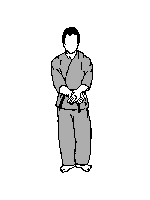
Kururunfa epitomizes the ideals of Go-"hard and Ju-"soft". Stance transitions are quick and explosive while the hands techniques are employed using "muchimi" or a heavy, sticky movement. As in the other kata of Goju-Ryu, it is quite evident that grappling and close-quartered fighting is the favored fighting style. The same kanji "fa"is found in Saifa. Again, this would suggest a strong emphasis on grappling. Where most other styles' Kata concentrate on "block/punch", it is obvious from the unique techniques that this is not the case with Goju-Ryu.
Suparinpei
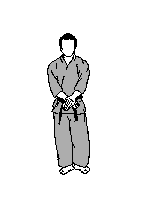
Suparinpei is the most advanced Kata in Goju-Ryu. It contains the greatest number of techniques and variations. Suparinpei is deceptive in that it appears simple in execution but when combined with transitions and changing tempos, it is only surpassed by Sanchin in technical difficulty and understanding. Once again, the number "108" is suggested to have origins in Buddhism and can represent the "108 sins of man". On the Chinese New Year, temple bells are rung 108 times to "drive away the evils of man". It is believed these named associations with Buddhism is based upon the lack of factual knowledge of the true nature of these.Secondly, with the cultural changes that took place in China during and after the Boxing Rebellion (1900) and the fall of the Qing Dynasty (1644-1911), little emphasis was placed on learning such complex arts. Most who learned the fighting arts after this time, did so as a means of exercise, recreation or artistic performance. In additon, the wide-spread use of firearms reduced the need and effectiveness for hand-to-hand combat as a means to civil defence.
Tensho - "Turning Palms"
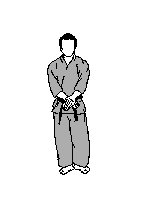
The second "heishu" kata in Goju-Ryu, Tensho is derived from the Chinese form "Rokkishu". Unlike Sanchin, which is almost identical to its Chinese counterpart, Tensho is uniquely Okinawan. From his understanding of the Kata of Goju-Ryu and the "nature of man", Miyagi Sensei developed Tensho to further complete his Goju-Ryu where Sanchin left off. Tensho has many of the same principles of Sanchin but goes further to include more intricate concepts of the techniques of Goju-Ryu. These concepts expressly come alive in kakie, which in advanced training, breathes life into the bunkai of the Kata of Goju-Ryu. The most notable difference between Sanchin and that of Tensho is that the breathing is explicitly different than that of Sanchin. The breathing of Tensho is not "hard" and external like Sanchin. The breath is internalized distinctively different and to the uneducated will appear to be the same as Sanchin. The term "heishu" translates as "closed". As with every aspect of Okinawan Karate, there is more than one definition. First, "heishu" can refer to muscle contraction and "ibuki" style breathing unique to Sanchin and Tensho. Secondly, it can imply the restriction and specific direction of energies within the energy pathways of the body, both superficial and deep. The other 10 Kata are referred to as "kaishu" or "open", as they are free of constant muscle contraction and breathing is "normal".
Sanchin - "Three Battles/Conflicts"

One of two "heishu " Kata of Goju-Ryu, Sanchin is probably the most misunderstood Kata in all of Karate. In contrast, it is probably the single most valuable training exercise in Goju-Ryu. Like the other Kata of Goju-Ryu, Sanchin can be found in several Chinese arts (San Jan), particularly the southern styles including four styles of Crane Boxing, Dragon Boxing, Tiger Boxing, Lion Boxing, Dog or Ground Boxing and Monk Fist. Sanchin has such aspects as deep, diaphragmatic breathing found in many internal arts as well as external attributes like mechanical alignment and muscular strength. Because many martial artists have little or no understanding of the true history and nature of the Chinese arts from which Okinawan Goju-Ryu has its roots, Sanchin has become little more than an isometric form performed with dangerous tension and improper breathing techniques. The original Sanchin that Higaonna Sensei learned from RuRuKo (1852-1930) was performed with open hands and with less emphasis on muscle contraction and "energetic" breathing. With the changes brought about by Emperor Meiji (Meiji Restoration Period 1888-1912), Higaonna Sensei changed the open hands to closed fists as the martial meaning was no longer emphasized. Later Miyagi Sensei would again alter the Kata in pattern alone. Sanchin translates as "3 Battles" or "3 Conflicts". This has many meanings. First it refers to the struggle to control the body under physical fatigue. With fatigue the mind begins to lose focus and thus the spirit begins to diminish as well. Therefore Sanchin develops discipline, determination, focus, perseverance and other mental attributes. The Chinese refer to this as Shen (spirit), Shin (mind) and Li (body). Another possible interpretation refers to the "Three Burners" of the body as decribed in Traditional Chinese Medicine (TCM).
Best Sneakers | jogging sets for young men by nike 270 Black/Green Strike DJ5136-001 , Fitforhealth